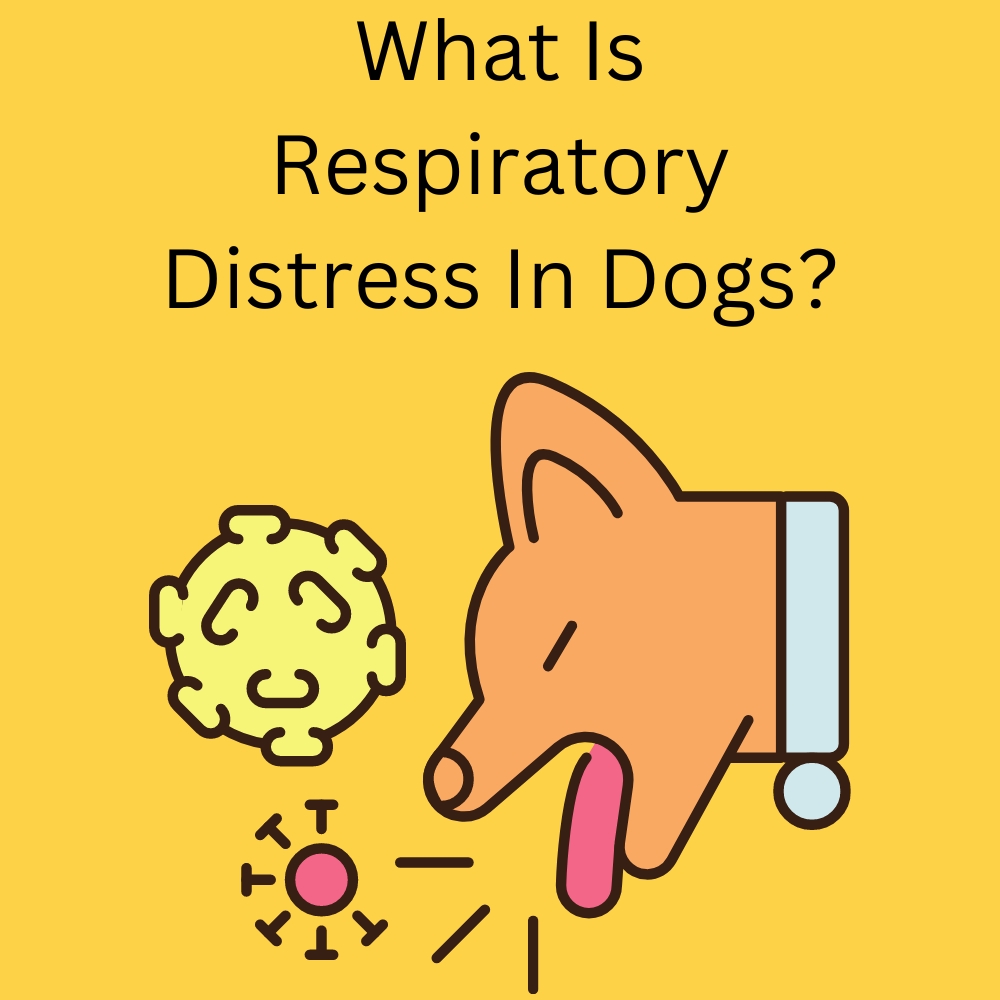Respiratory distress in dogs is a serious condition that can be unsettling and life-threatening. As a dog owner, recognizing the signs and taking prompt action are crucial to your pet’s well-being. This comprehensive guide will delve into the telltale symptoms of respiratory distress, its potential causes, and the immediate steps you can take to assist a dog in this critical state. Understanding this topic is not only beneficial in an emergency but can also complement regular monitoring to ensure your pet’s overall health and safety. Let’s explore how you can be prepared for such a situation and, most importantly, how you can help your beloved canine companion.
As mentioned above, respiratory distress in dogs is a severe condition that can be life-threatening if not treated promptly. It occurs when there is an obstruction or difficulty in the dog’s breathing, leading to inadequate oxygen supply to the body. In this guide, we will discuss everything you need to know about respiratory.
Defining Respiratory Distress in Dogs
Respiratory distress in dogs, also known as dyspnea, is characterized by labored breathing, wheezing, coughing, and other signs that denote a dog is struggling to get enough oxygen into their system. Although it is not a disease but a symptom, it is a red flag to serious underlying health issues that demand immediate attention. In some cases, respiratory distress can manifest as noisy or rapid breathing and even the dog’s inability to stand up due to weakness. It is crucial to understand that respiratory distress is not a diagnosis but a sign of an underlying condition that needs urgent medical attention.
Symptoms of Respiratory Distress in Dogs
Wheezing, rapid or shallow breathing, coughing, open-mouth breathing, blue gums, and visible discomfort are some common indicators. Dogs in respiratory distress may also exhibit an abnormal posture, with their neck and head extended to help open their airway.
Causes of Respiratory Distress in Dogs
Respiratory distress can be triggered by various factors, including allergic reactions, infections, physical obstructions, heart conditions, and even emotional responses such as anxiety or stress. Identifying the root cause requires professional vet diagnostics, as it often requires extensive examination and testing.
Underlying Conditions
Conditions such as pneumonia, laryngeal paralysis, heart disease, and cancers can manifest in respiratory distress. Identifying the specific condition is crucial for tailored treatment and management, often involving a combination of medical interventions and lifestyle changes.
First Aid for Dogs in Respiratory Distress
Immediate care can sometimes be the difference between life and death for a dog in respiratory distress. Here are the steps to take if you suspect your dog is experiencing difficulty breathing:
Remain Calm and Protect Your Pet
It’s essential to remain calm, as dogs can pick up on their owner’s stress, which can exacerbate their distress. Move your dog to a quiet, well-ventilated area to reduce any stressors that may be contributing to their condition.
Assess Breathing
First, determine the severity of the distress. If your dog is in severe respiratory distress, you need to get them to a vet as soon as possible. If the distress is mild to moderate, try to identify if there are any visible obstructions in the mouth or throat that you can safely remove.
Positioning for Easy Breathing
If your dog is having difficulty breathing, position them with their nose pointing upwards and neck extended. This can help create a straighter air passage, making it easier for them to breathe.
Provide Oxygen
If your dog is in severe distress, you can provide oxygen by blowing gently into their nostrils. However, it’s crucial not to do this if your dog is showing any signs of respiratory difficulties due to ingestion of a toxic substance, as doing so can risk inhaling the substance yourself.
Transport to the Veterinarian
It’s important to transport your dog to the vet immediately. Contact them beforehand so they are ready to attend to your dog as soon as you arrive. Monitor your dog’s breathing, and if their condition deteriorates, be prepared to perform CPR.
Prevention and Monitoring
Prevention is always better than cure, and respiratory distress can be avoided by ensuring your dog’s overall health and well-being. Regular check-ups, maintaining a healthy weight, proper dental care, and keeping an eye out for any potential allergens or irritants are some ways to help prevent respiratory distress in dogs. Additionally, monitor your dog’s breathing.
Managing Chronic Respiratory Conditions in Dogs
For dogs with chronic respiratory conditions, the key is proactive management through prescribed medications, recommended treatments, and creating an environment conducive to easy breathing.
Medications and Treatments
Depending on the diagnosis, your veterinarian may prescribe bronchodilators, corticosteroids, or antibiotics to manage the condition. They may also recommend nebulization therapy for inhaled medications that can help open the airways.
Lifestyle and environmental Adjustments
For dogs with respiratory issues, maintaining an ideal weight, avoiding respiratory irritants like smoke, and engaging in regular, gentle exercise can be supportive. Creating a low-stress, allergen-reducing home environment can significantly improve a dog’s quality of life.
Long-Term Care for Dogs That Have Recovered from Respiratory Distress
Once a dog recovers from an episode of respiratory distress, ongoing care is critical to prevent reoccurrence and monitor for any deterioration in their respiratory health.
Regular Check-Ups
Regular veterinary check-ups, which may include chest x-rays and blood tests, are imperative to monitor for any changes in your dog’s condition. This is particularly important if your dog has a history of respiratory issues, as catching concerns early can lead to more effective treatments.
At-Home Monitoring
As a dog owner, you play a vital role in day-to-day monitoring. Maintain a journal of any changes in your dog’s breathing patterns, appetite, or behaviour, as these can signal a shift in their health.
Engaging with Professional Support
Working closely with your vet and keeping lines of communication open can provide you with the support and knowledge needed to make informed decisions about your dog’s respiratory health. They can also help you establish a plan for emergency situations so you are prepared in case of another episode. Overall, being proactive and vigilant is crucial for managing respiratory distress and promoting the well-being of your canine companion. Always seek professional medical attention if you suspect your dog may be experiencing respiratory distress. By staying informed and taking the necessary precautions, you can help improve your dog’s quality of life and prevent potential health complications. So be a responsible dog owner, and don’t hesitate to contact your vet for any concerns about your furry friend’s respiratory health.
Conclusion
Respiratory distress in dogs can be an alarming experience, but with knowledge and preparation, you can take immediate steps to support your pet. By understanding the symptoms, causes, first aid, and long-term management, you empower yourself to provide the best care for your furry friend. Remember, a quick response combined with professional veterinary care is the recipe for a positive prognosis. Stay attuned to your dog’s health, and do not hesitate to seek emergency care if you suspect respiratory distress. Your vigilance and action could save a life. So, keep calm and take the necessary steps to protect your pet’s health. Together, we can ensure our canine companions live happy and healthy lives.
Resources
- American Kennel Club (2021). “Dog First Aid: How to Treat Dog Respiratory Distress.” AKC.org.
- VCA Animal Hospitals (2021). “Difficulty Breathing in Dogs.”. VCAHospitals.com.
- PetMD (2021). “Coughing in Dogs: Causes and Treatment.”. PetMD.com.
- Journal of Veterinary Internal Medicine (2019). “Clinical Signs, Diagnosis, and Treatment Outcome in 24 Cats With Pulmonary Parenchymal Disease Caused by Prototheca spp.”. Wiley Online Library.
- O’Neill, D.G., et al. (2021). “Longevity and Mortality of Owned Dogs in England.”. Nature.com.
- Royal Society for the Prevention of Cruelty to Animals (2021). “Pet Care Advice: Respiratory Disease in Dogs”. RSPCA.org.uk. Conjoined twins are identical twins that are physically connected to each other at birth. Their bodies may be joined at various points, including the head, chest, abdomen, pelvis, or spine. This rare phenomenon occurs in approximately 1 in every 200,000 live births.
FAQs
Q1: What are the 3 major signs of respiratory distress?
Ans1: The three major signs of respiratory distress in dogs are difficulty breathing, an increased breathing rate, and excessive coughing or wheezing.
Q2: What does respiratory distress look like in a dog?
Ans2: Respiratory distress in a dog may look like rapid, shallow breathing, open-mouthed breathing, blue-tinged gums, and an inability to lie down or rest comfortably.
Q3: Can a dog survive respiratory distress?
Ans. 3: Dogs can survive respiratory distress with prompt and appropriate treatment, but the severity of the condition and underlying causes may impact their overall prognosis.
Q4: How do you treat respiratory distress in dogs?
Ans4: Treatment for respiratory distress in dogs may involve oxygen therapy, medications, and environmental management, depending on the specific diagnosis.




